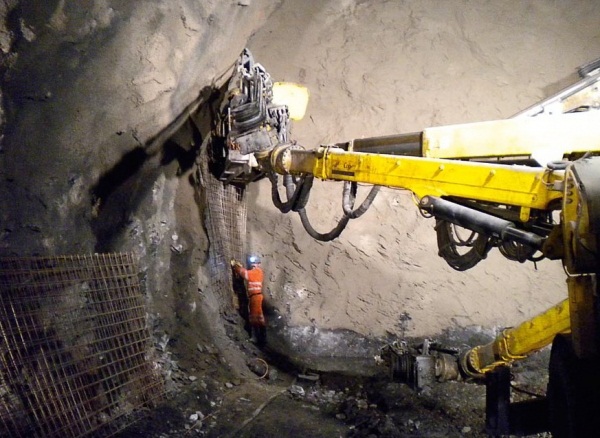Fibre-reinforced sprayed concrete

Fibre-reinforced sprayed concrete has now become much more important due to the development of new and more effective types of fibre, its increasing availability and its inclusion in various standards. It can be considered the perfect combination with sprayed concrete. Like conventional concrete, sprayed concrete is a brittle material with limited tensile and bending strength but very good compressive strength. It is certainly possible to reinforce sprayed concrete with conventional steel reinforcement, but its installation is very labour intensive, time-consuming and frequently in conditions that are still safety critical.
Also, reinforcing bars are not well adapted to the flexible layer thickness design of sprayed concrete. This is why it makes sense to use fibre-reinforced sprayed concrete. Its main advantages are:
- homogeneous distribution of the fibre reinforcement in the sprayed concrete
- great improvement in the sprayed concrete ductility
- higher tensile strength in bending
- greater security due to high post-cracking strength
- increased impact resistance
- improved adhesive strength
- reduced early shrinkage cracking behaviour
- increased fire resistance
In principle, all fibre types and materials are suitable for sprayed concrete, where the material is used in tunnelling, steel fibre is generally most appropriate. Carbon fibre has ideal properties but is completely uneconomic for use in conventional sprayed concrete.
Glass fibre is only suitable for special fine-particle applications and has to meet special requirements for its long-term behaviour. Polymer fibre is mainly used for concrete repairs because it improves the internal cohesion of the sprayed concrete and reduces shrinkage cracking during early strength development. Plastic fibre improves the fire resistance of concrete in general. Modern generations of plastic fibres are now appearing in the traditional steel fibre applications.
Steel fibre surposses reinforcing bars and mesh on cost-performance in nearly every case.
The following guidelines apply to fibre-reinforced sprayed concrete production:
- The fresh concrete consistency must be more plastic so that the fibre-reinforced sprayed concrete can be pumped.
- Due to the larger surfaces, the lubricant and adhesive film requirement is greater and therefore the binder content must be increased.
- The adhesive properties are improved by the use of silica-fume.
- The point for adding the fibre depends on the type of fibre and can be changed if problems occur (e.g. spiking).
- Remember that fibres are also lost with the rebound and therefore the content and efficiency of the sprayed concrete are the determining factors, not the theoretical steel fibre dosage.

